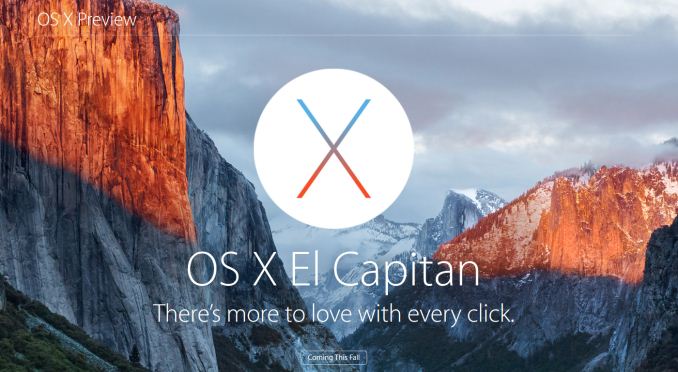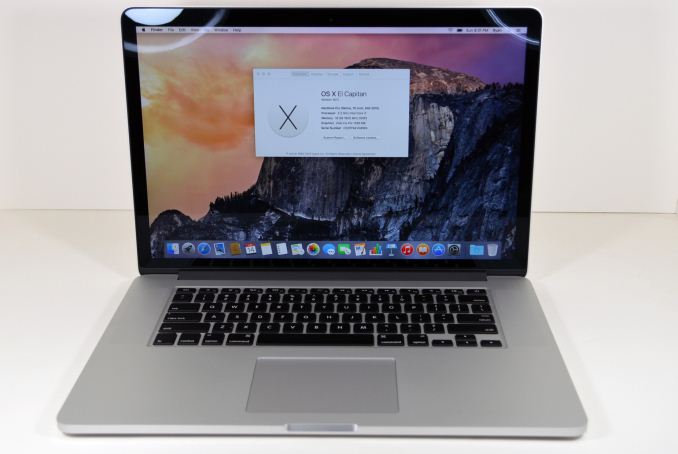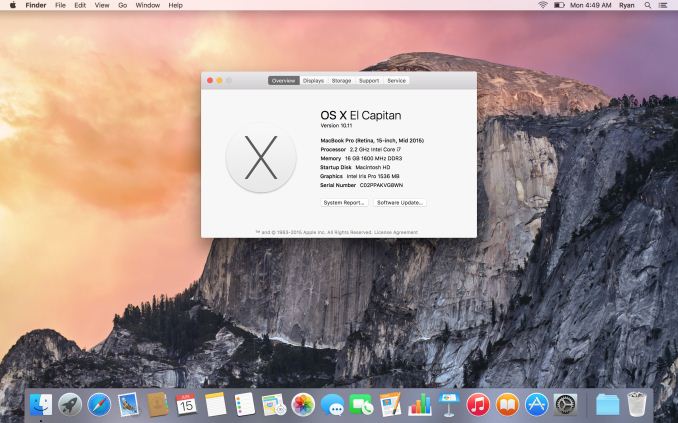A First Look At Apple's OS X El Capitan
by Ryan Smith on June 15, 2015 3:00 PM EST- Posted in
- Apple
- Mac
- Operating Systems
- macOS

Right on schedule, at last week’s World Wide Developers Conference Apple announced the next iteration of their desktop OS, OS X. Version 10.11, dubbed El Capitan, is the latest in Apple’s string of yearly OS updates. And with this now being the 3rd iteration of the company’s initiative to offer free desktop operating system upgrades, it’s safe to say that the company has settled into what is the new norm.
From an OS perspective, WWDC straddles an interesting point between announcing new OSes and priming developers for them. The sole public session of the conference is the Keynote, where Apple announces the newest versions of OS X, iOS, and whatever other major initiatives they have going on. However once the keynote is done, that’s it for the public. The company has plenty of other activities going on at WWDC, but those are closed door events for attending developers. Ultimately there’s no practical way for Apple to announce something major like a new OS to developers without the news leaking, so the company instead does a public announcement to get consumers and developers excited while neatly sidestepping the immediate issue with keeping such a big secret, and then closes up to get to work on preparing developers for their latest OSes.
Of course developers can only do so much without seeing the OS first-hand, so along with serving as a developers conference and keynote backdrop, WWDC also serves as the launching point for Apple’s OS betas for developers. Over the next few months OS X and iOS 9 will go from a developer beta to a public beta, and finally to retail products. Which is to say that developers get to have all the fun of actually interacting with the OS first, as the public beta won’t start for another month or two.
And that, at last, brings us to today. With thousands of developers and no practical way to keep the OS from leaking, Apple is seemingly trying something a little different this year when it comes to engaging consumers and the press during the developer beta period. Rather than clamming up entirely – developers are under non-disclosure agreements – Apple invited us to take a first look at the beta OS, loaning us a 2015 15-inch Retina MacBook Pro with OS X El Capitan preloaded. To that end, today we are taking our first look at El Capitan, checking out the major new features of the OS and experiencing first-hand the software Apple is putting together for later this year.
Now make no mistake, this is a beta OS and it has problems like any piece of beta software does – Apple does not withhold OS betas from the public just because they like to be secretive – but it’s an increase in transparency from a very opaque company. More to the point, while El Capitan still has some debugging to go through and a few teething pains that come with it, it’s already in a state where it’s usable, where the major features are in place and working, and the bugs Apple hasn’t already squashed can be worked around by an experienced hand. So with that in mind, let’s take a look at what Apple is gearing up for with the 12th iteration of OS X.
Sizing Up El Capitan
First off, to address the obvious question in the room, why “El Capitan?” With Apple dropping the big cat codenames a couple of years back, they have now started naming OS X after California landmarks. With 10.10 Apple named the OS after Yosemite National Park, and now with 10.11 El Capitan, they have gone one step further and named the OS after the El Capitan rock formation.
El Capitan is admittedly a bit of a mouthful, especially if you’ve never heard the accent pronounced before (it’s pronounced el-KAP-i-TAN, by the way), however the name is fitting from a development standpoint. Whereas Yosemite was a major OS release for Apple, involving a significant UI overhaul along with numerous feature upgrades, El Capitan is a far tamer excursion for Apple. It’s still an important release for its own reasons, but it’s definitely an iteration on Yosemite rather than another major change; it is the Mountain Lion to Lion, the Snow Leopard to Leopard. So it’s only fitting that with such close ties to Yosemite, it’s named after a rock within the park.
Ultimately with the company no longer charging for OS updates, they can afford to take on a build-and-optimize approach, since no matter how many new features an OS comes with it’s still free. At the same time it means that El Capitan gets to build off of a solid base in Yosemite, which means Apple can focus on other areas of the OS.
So what does El Capitan bring to the table? Over the next couple of pages we’ll lay out the major features, but in a nutshell it’s an interesting combination of some further harmonization with iOS, some new features for the OSes major applications, and even some core technology updates. Mentioning iOS and OS X in the same breath always draws a few groans, and while some of the iOS elements that have come to past OS X releases has been more tepidly received than other elements, in the case of El Capitan it feels like Apple has a better grip on harmonizing the OSes without losing what makes OS X unique, and what makes a desktop OS work best.












100 Comments
View All Comments
robcov33 - Monday, June 15, 2015 - link
Why waste space with any apple product?V900 - Monday, June 15, 2015 - link
Cause they're by far the biggest manufacturer of premium laptops, tablets and smartphones?Apple got around 90% of the +600$ smartphone market and over 80% of the +1000$ computer market.
That means that they're a huge part of the industry, and even the people who exclusively use 500$ HP laptops, such as perhaps yourself, are affected by their products and decisions.
jimmy$mitty - Tuesday, June 16, 2015 - link
That is vastly wrong. Apple has, of all the PCs sold, 13% market share roughly. They do not have 80% of the $1000+ laptop market as there are more options available from PC than there are from Apple.And Apple doesn't do anything for design nor are PCs run by their decisions. If they were we would all be using Firewire instead of USB. Half the time their products are behind the PCs in the latest technology.
NEDM64 - Wednesday, June 17, 2015 - link
You use USB because Apple pushed hard that standard with the original iMac.FireWire? FireWire is an IEEE standard.
And speaking about IEEE standards, Apple was on the first to push WiFi as a standard, with their consumer AirPort base stations, and AirPort interface cards, that came standard in most models, and turned 802.11 in a standard.
Just because you are not a professional, doesn't mean that other people don't use professional standards...
For example, the relatively cheap, FireWire connected, iSight camera was a staple in computer vision applications in mid-2000s, because it was cheap, and had much less lag, much better frame rate, much better, uncompressed image than any USB camera
Oxford Guy - Wednesday, June 17, 2015 - link
Firewire was a lot better than USB, except with Windows XP thanks to Microsoft's purposefully bad driver.And, had Apple not chosen to start using Intel hardware, Firewire would be really fast today. There are a bunch of faster versions that were in planning and development.
masouth - Tuesday, June 16, 2015 - link
While I agree that it needs to be covered, your reasoning is a bit specious.1) the smart phone market share doesn't mean anything at all when talking about OSX and mentioning it is just a red herring.
2) Simply being dominant in a certain market doesn't necessarily make you a HUGE part of an industry. Apple is certainly an important part of the market and they are a dominant force in the $1000+ market but have you ever looked at what their overall share of the PC market is? 15% in the US? Half of that world wide. Apple's total market share is smaller than the INDIVIDUAL market share of several of the WinPC vendors (HP, DELL, Lenovo, etc).
This needed to be covered simply because it is an update to the largest retail OS not named Windows and Apple is a media juggernaut that would get covered even if they started making toilet seats. Please don't try to delude people into believing that it has anything to do with iPhones or how few PC's Apple can push over a certain arbitrary price point.
serndipity - Tuesday, June 16, 2015 - link
Based on 2014 PC shipments, according to both IDC or Garnter, Apple's market share is 6% (up by 1% from 10 years ago).Additionally, from Consumer Reports 2015 buying guide, of the 25 computers rated, the best Apple best only placed 9th out of the 25, which was significantly, overall 20 points lower than their top pick (i.e. Dell).
Based on Apple's 2015 hardware and software offerings, it appears that their market share will fall back into the 4 - 5% of range.
Oxford Guy - Wednesday, June 17, 2015 - link
Consumer Reports' recommendations range from fairly informed to highly flawed.Bansaku - Friday, June 19, 2015 - link
Numbers are skewed, they don't take into account for 'personal sales' vs 'sales on the whole' (aka personal sales AND business sales). The majority of my friends, family, and co-workers own a Mac for their personal use. 100% of them use PCs in their workplace. If Apple wasn't selling enough computers for personal use they obviously would not be making a profit and year after year selling MILLIONS of Macs.techconc - Tuesday, June 23, 2015 - link
If you're interested in a toaster, Consumer Reports is a reasonable source. If you're discussing anything related to consumer electronics, they are demonstrably incompetent. As an example, a professional photographer isn't going to consult CR for their next purchase and the evaluation criteria CR uses for products is often bizarre.